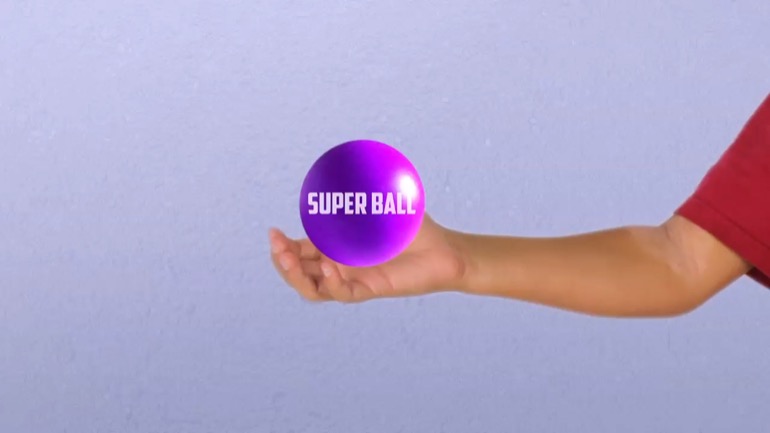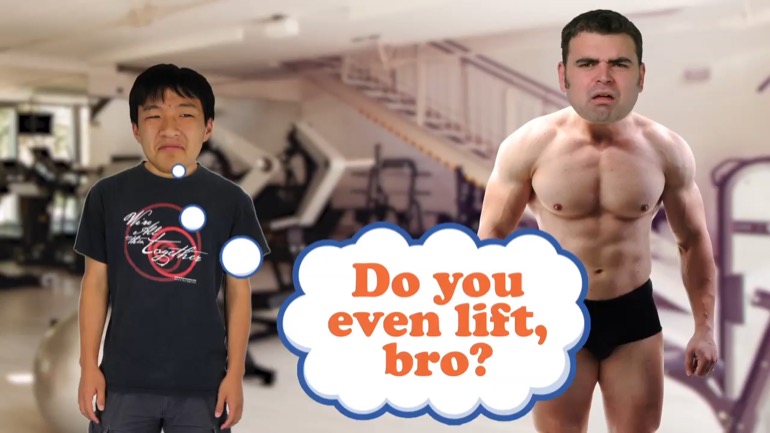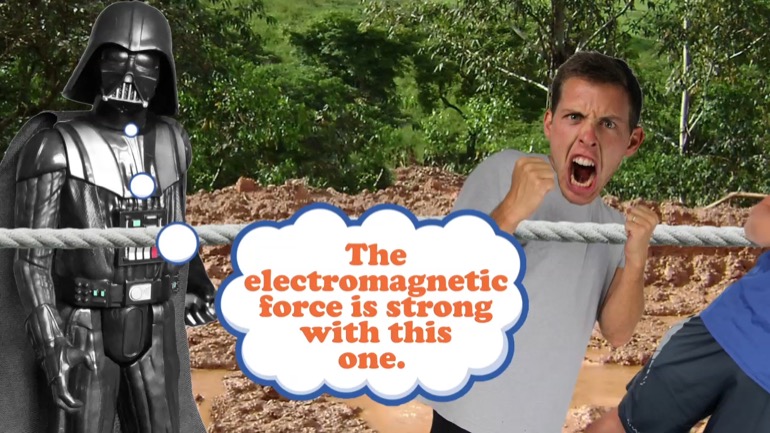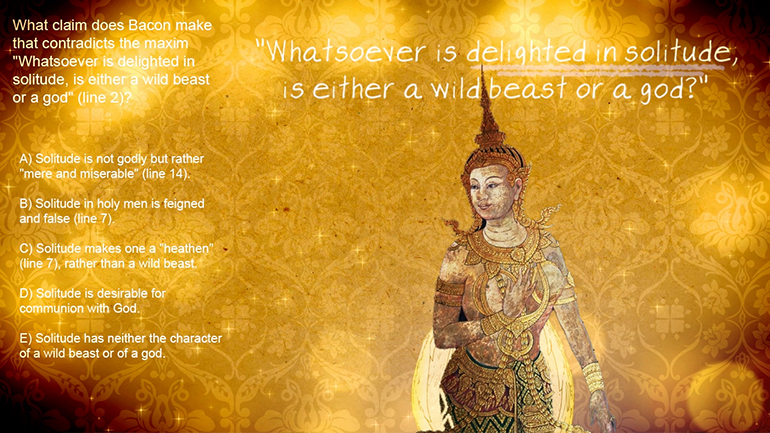ShmoopTube
Where Monty Python meets your 10th grade teacher.
Search Thousands of Shmoop Videos
Physics Videos 34 videos
Isaac Newton. Who was he? Why do we need to know about him? In a physics course, no less? Well, he's only the most famous physicist in history, and...
What are the basics of trigonometry? And why are we learning about this in a physics course? Both good questions. In this video, you'll learn about...
It's time to make our liters and meters work together. Enough of the bickering, right? In this video, we'll do some unit analysis, covering SI Unit...
Physics: Phase Changes on a Molecular Level 12 Views
Share It!
Description:
Let's look at phase changes on a molecular level. Get your miniaturizing ray guns ready.
Transcript
- 00:02
Phase changes on a molecular level let's get particular....
- 00:25
sawing a woman in half is so cliche and [Magician sawing woman in half]
- 00:30
all that is this your card stuff, i'd leave it for the hacks in Vegas nope my
- 00:36
tricks are way better sure maybe they take a little more time maybe but all
- 00:41
good art does so for my next trick I'm gonna make this solid block of ice into [Magician with big block of ice]
Full Transcript
- 00:47
liquid okay so maybe watching ice melt isn't your idea of magic
- 00:51
maybe reminds you of Mrs. Chimel Farbs grammar class but underneath it all on a
- 00:56
molecular level well some pretty crazy stuff is happening phase transitions
- 01:02
really are kind of magical by which I mean most people don't really understand [People sleeping in the audience]
- 01:07
what's happening and there are things going on that your eyes can't see... Take
- 01:11
this big block of ice for example it looks well a lot like ice cold solid
- 01:17
boring ice just sitting there not moving but inside the ice like way inside
- 01:23
everything is moving if we were able to look at the molecules in this ice cube [Molecules moving]
- 01:28
well we'd see a whole lot of buzzing going on the molecules would be packed
- 01:32
together in an orderly fashion kind of like fans at a football stadium but
- 01:36
excited fans who are all vibrating like Packer fans and if you give the ice cube
- 01:41
a little heat well all they might all do the wave....
- 01:46
and as the IceCube receives heat from the air around it well, the molecules [Molecules vibrate]
- 01:51
start to vibrate more and more it's like when the home team is making a
- 01:54
last-minute drive for the winning touchdown and you know what let's keep
- 01:59
this metaphor going once the frozen water has gotten enough heat and has hit
- 02:04
a specific temperature it's like the home team just caught a Hail Mary pass [Man catches football in end zone]
- 02:08
The bonds that we're keeping the molecules tightly bound to each other
- 02:12
are broken and the molecules are able to slip past each other and move around
- 02:16
more freely like fans storming the field the molecules are still contained in the [Molecules run onto football field]
- 02:22
stadium but they're moving past each other under each other just to go nuts
- 02:26
and here's where the whole fans at a football stadium game thing well it kind
- 02:30
of breaks down see when you heat up a solid it gets hotter meaning its
- 02:34
temperature gets higher makes sense right but when it starts to melt its
- 02:38
temperature stops increasing every substance has a melting point even the [Fire burning metal]
- 02:44
Grinch's heart... Once the temperature hits that magical melting point, things
- 02:48
start to get runny but that process doesn't happen all at once an ice cube
- 02:53
doesn't just turn into liquid water in an instant it melts gradually and the
- 02:58
part that still solid stays at the same temperature even though it continues to
- 03:03
take in heat all the heat that's taken in just makes things melt more quickly [Snow melting on the ground]
- 03:07
the amount of heat that it takes to turn an entire solid liquid without changing
- 03:13
its temperature is called the heat of fusion and we're not using fusion in the
- 03:18
nuclear sense here people which is good because if it was a nuclear reaction [Magician with ice cube and ice cube explodes]
- 03:22
every time an ice cube melted well we'd be in trouble you can look at the
- 03:27
ancient Latins for this one the original root word for fusion is Fundere...
- 03:32
which means to melt or to pour and we know how much science loves it's
- 03:38
dead languages so of course well they kick it old-school with the original
- 03:42
meaning scientists are the worst right? like why can't they be cool and hip like
- 03:47
magicians okay so now we've got ourselves a puddle [Magician with a puddle on stage]
- 03:52
a magic puddle that is but the show doesn't end there my friends oh no
- 03:56
there's plenty more magic where that came from because once again with just
- 03:59
the power of heat I can make this puddle disappear into thin air in fact I can
- 04:04
make it vaporize yeah vaporization evaporation
- 04:08
whatever you want to call it when a substance reaches its boiling point it [Water boiling in a pan]
- 04:11
stops being liquid and it becomes a gas now of course water doesn't need to get
- 04:15
up to 212 degrees Fahrenheit to evaporate the individual molecules are
- 04:20
able to get enough energy to turn into gas even at room temperature I prove
- 04:26
that every night with a magic trick I like to call pop-sweat yeah but adding
- 04:30
heat guarantees a gas state when we keep adding heat to our liquid water well,
- 04:35
the molecules keep moving faster and faster but they're still bonded together [Molecules moving]
- 04:39
they can't bounce themselves completely free at least not yet
- 04:43
which is why liquids maintain their volume if you take a gallon of water and
- 04:47
poured into a kiddy pool you're still gonna have a gallon of water and you're
- 04:52
also gonna have a really lame pool party well the water isn't going to expand and
- 04:57
somehow fill the pool liquids maintain their density and they also can't be
- 05:01
compressed that compression thing is important to imagine you have a tube of
- 05:06
water it's closed on one end and open on the other and you've got some sort of [Man with a tube of water]
- 05:11
plunger mechanism you know like how a syringe works try as you might you're
- 05:15
not gonna be able to press down on that plunger to make the water take up less
- 05:18
space which is a good thing because that's how the brakes on your car work a
- 05:22
squirrel with a death wish runs out into the street you mash the brake pedal and
- 05:26
the pressure from your foot is delivered via break fluid to the wheels [Car brakes rapidly]
- 05:31
and sure that's simplifying things a bit but I'm a magician not a car explainer
- 05:36
guy all right well where were we oh yeah doing my magic aquatic disappearing
- 05:40
trick by which I mean boiling water and the molecules were starting to go
- 05:45
bonkers the water gets hotter and hotter and finally reaches its boiling point
- 05:49
when boiling starts the molecules have enough energy to break the bonds holding
- 05:53
them together and they're finally free able to move around completely
- 05:56
independent of each other because they've transition to become a
- 05:59
gas just like when a solid starts to melt when a liquid starts to turn into [Magician holding pan of water]
- 06:04
gas the liquid stays at the same temperature even though it continues to
- 06:07
take on heat well the extra energy allows the molecules to break free
- 06:10
by definition water above 100 degrees Celsius becomes vapor so if it's liquid
- 06:16
it can't be hotter than that right only when all liquid has been converted to
- 06:20
gas can the thermometers start going up again and this amount of heat required
- 06:25
to turn a liquid into gas is called the heat of vaporization now for the second [Magician holding act 2 sign]
- 06:31
part of my act I'm gonna reverse all of this magic and turn this vapor back into
- 06:35
a solid quick question though how good is the air conditioning here hmm see
- 06:41
we're gonna need to get things cold enough that all the water we heated up
- 06:45
now has to give up heat to the system around it the temperature where a gas
- 06:50
turns into a liquid is called the condensation point and that temperature
- 06:54
is exactly the same as the boiling point for whatever substance we're talking
- 06:58
about well the process just works the other way around instead of heat going [Molecules appear]
- 07:02
into this substance getting these molecules all jazzed up heat comes out
- 07:07
of the substance think about a pot of boiling water the lid of the pot will
- 07:11
have a lot of water condensed on it and that's because the lid is cooler than
- 07:14
the water so when the water vapor comes into contact it cools down suddenly and
- 07:18
cools down enough to turn back into a liquid and you might have a couple of [Magician holding an ice cube tray]
- 07:23
trays like these in your freezer right when you've used the last ice cube and
- 07:27
you don't want to get yelled after leaving an empty ice tray in the freezer
- 07:30
well you fill it up with liquid water and pop it back in the water has a
- 07:35
higher temperature than the air surrounding it so it starts giving off
- 07:38
heat but once the waters temperature reaches the freezing point which fyi
- 07:42
is the same as the melting point well those molecules start to get back in
- 07:47
line and just like before the water can't get [Ice cube tray in a freezer]
- 07:50
colder than the freezing point until all of it has been converted to a solid
- 07:55
abracadabra what once was wet now is dry all thanks to my magic and physics but
- 08:02
you know mostly my magic well there's one other state of matter which we
- 08:06
haven't talked about yet and we know if we give a solid enough heat it'll
- 08:10
eventually change into a gas but what happens if we keep heating that gas up
- 08:14
does it just stay gassy no as things get hotter and hotter the molecules get more
- 08:21
and more worked up eventually there's so much energy that electrons start popping
- 08:26
off their atoms creating electrically charged molecules called ions this [ions appear beside water molecules]
- 08:32
ionized gas becomes the fourth state of matter called plasma plasma is what
- 08:38
stars are mostly made up of and we use it on earth for things like welding
- 08:42
making computer chips and most importantly yes TVs yep this odd state
- 08:48
of matter is responsible for delivering sweet mind-numbing reality entertainment [Woman flicking through TV channels]
- 08:53
right into our brains and although we don't run into it very often here on
- 08:57
earth almost all of the matter in the universe is actually plasma but we can't
- 09:02
really make plasma on our kitchen stove so we're not gonna get too deep into
- 09:06
that right now well one thing that might seem like
- 09:09
magic is how all these different states of matter can exist at the same
- 09:14
temperature when it's 72 degrees outside water is liquid oxygen is gas and pizza
- 09:19
is solid how is that possible people everything is made up of the same
- 09:23
building blocks right? well yes and no different substances have different
- 09:28
chemical properties some molecules have electrons that aren't too attached to [Electron spinning round orbital of molecule]
- 09:32
them so energy is able to flow more easily between those molecules and the
- 09:35
shape size and mass of the molecules all affect how it reacts to heat and how it
- 09:41
changes phases well polarity also matters polarity is
- 09:46
when one side of a molecule has more electrons creating a partial electrical
- 09:50
charge and pressure can change boiling and melting points too.. generally speaking
- 09:55
if pressure increases so does the melting and boiling point and if we
- 09:59
lower pressure and a substance will melt and boil at a lower temperature too.. All of
- 10:05
these factors combine to make the wonderful diverse universe we live in
- 10:08
everything looks a little more magical now doesn't it we can graph all these [A field and pool appear]
- 10:13
phase changes too - take a look at this graph this is a heat curve for water
- 10:18
okay it's not the sexiest of curves heat curve is a more of a name rather than a [Magician discussing heat curve graphs]
- 10:23
description there all right well we've got temperature on the y-axis and heat
- 10:28
on the x-axis yeah not time which is different than a lot of graphs that
- 10:31
we've worked on before usually the x-axis is time right but we don't care
- 10:35
about time in this case, this is all about how much heat it takes to
- 10:39
change the state of a substance and heat is measured in joules or kilo joules as
- 10:45
we have on our graph here right there now let's actually look at the line on [Line on water heat curve graph shown]
- 10:49
this thing we have periods where the temperature increases and times when it
- 10:53
plateaus well what's going on in these different segments? well like we said
- 10:58
when something melts its temperature doesn't increase until it's all the way
- 11:01
melted so these flat sections are where the transitions are happening and in
- 11:06
these parts where the temp is going up well the state of the matter is staying
- 11:10
the same we'll start at the left when things are pretty chill we know that
- 11:14
we've got a solid chunk of ice when things are this cold and it can take a
- 11:17
bunch of heat before anything interesting happens I'm guessing [People stood by an ice cube block]
- 11:21
watching ice get warmer is right up there with watching paint dry in the
- 11:24
pantheon of boring activities but as we get it up to zero we hit plateau number
- 11:29
one at the end of that section the thermometer starts going up again so we
- 11:33
know the phase transition is over we're all wet now then we have another flat
- 11:38
spot which you guessed it means another transition after a whole bunch more heat [Graph pointer moves along heat curve line]
- 11:42
or into gas land and this graph doesn't go all the way to plasma so we're not
- 11:47
gonna sweat that transition alright so we have
- 11:50
our melting point right here at zero degrees but what if we're reading this
- 11:53
graph from right to left like it's Hebrew or something well then we've got
- 11:57
freezing going on instead of melting it just depends on which direction we're
- 12:02
going and it's the same thing with boiling and condensing it's a matter of
- 12:06
which way we're you know walking the line all right
- 12:10
now what is our heat of fusion remember that's how much energy it takes to get [Heat of fusion graph appears]
- 12:14
from solid to liquid all the heat we pump in for this first flat section is
- 12:19
the heat of fusion if we had actual numbers on this graph we could just
- 12:23
subtract the lower heat amount here on the right from the higher heat amount
- 12:27
here on the left but we don't have numbers so you know just remember that
- 12:31
process and it's the same for the heat of vaporization we could calculate the
- 12:36
exact amount of heat by subtracting the heat at the start of the transition from
- 12:39
the heat at the end and we can do this kind of thing for any substance at all
- 12:43
this is a graph or some unknown substance yeah all right we can see that [heat of fusion graph for unknown substance]
- 12:47
it doesn't take a whole lot of heat to make its temperature increase when it's
- 12:50
a solid then it hits a phase transition at 55 degrees and it takes about 15
- 12:56
kilojoules of heat to completely turn into a liquid when it reaches 65 degrees
- 13:02
we get to phase transition number two and it requires 20 kilojoules to turn
- 13:07
our mystery heat into gas then the temp increases more gradually as we pump in
- 13:13
more thermal energy give us a thermometer a blowtorch and a bunch of [Thermometer and blowtorch appear]
- 13:17
different materials and we could make graphs like this all day which actually
- 13:21
sounds like a fun afternoon.... all right well things these days are
- 13:26
kind of slow turns out that when you advertise yourself as the magic [Melto magician advert appears]
- 13:30
physicist well people expect you to do a little
- 13:32
more than make ice melt and you don't get a lot of those harde gigs
- 13:36
with your amazing boiling water act... sorry maybe I should consider a phase [Kids throw tomatoes at magician]
- 13:41
transition of my own well now for my next trick I'm gonna turn potatoes into
- 13:46
French fries yeah I should have stayed in college
Related Videos
When you're about to marry the love of your life, not many things could stop you. However, finding out that your future hubby is keeping his crazy...
Here at Shmoop, we work for kids, not just the bottom line. Founded by David Siminoff and his wife Ellen Siminoff, Shmoop was originally conceived...
ACT Math: Elementary Algebra Drill 4, Problem 5. What is the solution to the problem shown?
AP® English Literature and Composition Passage Drill 1, Problem 1. Which literary device is used in lines 31 to 37?
AP® English Literature and Composition Passage Drill 2, Problem 1. What claim does Bacon make that contradicts the maxim "Whatsoever is delig...






































